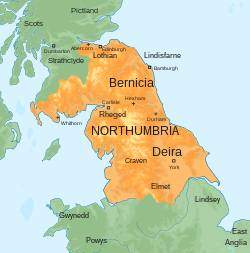
Back Norþhymbra Rīce ANG نورثمبريا Arabic Reinu de Northumbria AST نورثامبریا کراللیغی AZB Northumbria BAR Нартумбрыя Byelorussian Нартумбрыя BE-X-OLD Rouantelezh Northumbria Breton Northúmbria Catalan Northumbrie Czech
Kingdom of Northumbria | |||||||||||||
|---|---|---|---|---|---|---|---|---|---|---|---|---|---|
| 651–954 | |||||||||||||
 Northumbria at its greatest extent around 700 AD | |||||||||||||
| Status | Unified Anglian kingdom (651–867) North: Independent Anglian ruled territory (after 867-927) South: Viking-ruled York (867–927; 939–944; 947–954) | ||||||||||||
| Common languages | Northumbrian Old English Cumbric Latin Old Norse | ||||||||||||
| Religion | Paganism (before 7th century) Christianity (after 7th century) | ||||||||||||
| Demonym(s) | Northumbrian | ||||||||||||
| Government | Monarchy | ||||||||||||
| King of Northumbria | |||||||||||||
| History | |||||||||||||
• Established | 651 | ||||||||||||
• Deira is conquered by Vikings[1] | 867 | ||||||||||||
| 927 | |||||||||||||
| 954 | |||||||||||||
| Currency | Sceat, penny | ||||||||||||
| |||||||||||||
| Today part of | |||||||||||||
Northumbria (/nɔːrˈθʌmbriə/; Old English: Norþanhymbra rīċe [ˈnorˠðɑnˌhymbrɑ ˈriːt͡ʃe]; Latin: Regnum Northanhymbrorum)[2] was an early medieval Anglian kingdom in what is now Northern England and South Scotland.
The name derives from the Old English Norþanhymbre meaning "the people or province north of the Humber",[3] as opposed to the people south of the Humber Estuary. What was to become Northumbria started as two kingdoms, Deira in the south and Bernicia in the north. Conflict in the first half of the seventh century ended with the murder of the last king of Deira in 651, and Northumbria was thereafter unified under Bernician kings. At its height, the kingdom extended from the Humber, Peak District and the River Mersey on the south to the Firth of Forth on the north. Northumbria ceased to be an independent kingdom in the mid-tenth century when Deira was conquered by the Danes and formed into the Kingdom of York. The rump Earldom of Bamburgh maintained control of Bernicia for a period of time; however, the area north of the Tweed was eventually absorbed into the medieval Kingdom of Scotland while the portion south of the Tweed was absorbed into the Kingdom of England as the county of Northumberland and County Palatine of Durham.
- ^ a b c Holdsworth 2014, p. 341.
- ^ Bede 1898 Book I, chapter 34
- ^ Bosworth 1898, p. 725